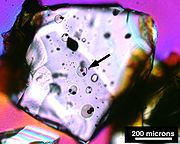
Melt Inclusions
Encyclopedia

Magma
Magma is a mixture of molten rock, volatiles and solids that is found beneath the surface of the Earth, and is expected to exist on other terrestrial planets. Besides molten rock, magma may also contain suspended crystals and dissolved gas and sometimes also gas bubbles. Magma often collects in...
s that form igneous rocks. In many respects they are analogous to fluid inclusions
Fluid inclusions
thumb|250px|Trapped in a time capsule the same size as the diameter of a human hair, the ore-forming liquid in this inclusion was so hot and contained so much dissolved solids that when it cooled, crystals of halite, sylvite, gypsum, and hematite formed. As the samples cooled, the fluid shrank more...
. Melt inclusions are generally small - most are less than 100 micrometre
Micrometre
A micrometer , is by definition 1×10-6 of a meter .In plain English, it means one-millionth of a meter . Its unit symbol in the International System of Units is μm...
s across (a micrometre is one thousandth of a millimeter, or about 0.00004 inches). Nevertheless they can provide an abundance of useful information. Using microscopic observations and a range of chemical microanalysis
Microanalysis
Microanalysis is the chemical identification and quantitative analysis of very small amounts of chemical substances or very small surfaces of material...
techniques geochemists and igneous petrologists
Petrology
Petrology is the branch of geology that studies rocks, and the conditions in which rocks form....
can obtain a range of useful information from melt inclusions. Two of the most common uses of melt inclusions are to study the compositions of magmas present early in the history of specific magma systems. This is because inclusions can act like "fossils" - trapping and preserving these early melts before they are modified by later igneous processes. In addition, because they are trapped at high pressures many melt inclusions also provide important information about the contents of volatile elements (such as H2O, CO2, S and Cl) that drive explosive volcanic eruptions
Volcano
2. Bedrock3. Conduit 4. Base5. Sill6. Dike7. Layers of ash emitted by the volcano8. Flank| 9. Layers of lava emitted by the volcano10. Throat11. Parasitic cone12. Lava flow13. Vent14. Crater15...
.
Sorby
Henry Clifton Sorby
Henry Clifton Sorby , was an English microscopist and geologist.-Biography:Sorby was born at Woodbourne near Sheffield in Yorkshire and attended Sheffield Collegiate School. He early developed an interest in natural science, and one of his first papers related to the excavation of valleys in...
(1858) was the first to document microscopic melt inclusions in crystals. The study of melt inclusions has been driven more recently by the development of sophisticated chemical analysis techniques. Scientists from the former Soviet Union lead the study of melt inclusions in the decades after World War II
World War II
World War II, or the Second World War , was a global conflict lasting from 1939 to 1945, involving most of the world's nations—including all of the great powers—eventually forming two opposing military alliances: the Allies and the Axis...
(Sobolev and Kostyuk, 1975), and developed methods for heating melt inclusions under a microscope, so changes could be directly observed.
Although they are small, melt inclusions may contain a number of different constituents, including glass (which represents magma that has been quenched by rapid cooling), small crystals and a separate vapour-rich bubble. They occur in most of the crystals found in igneous rocks and are common in the minerals quartz
Quartz
Quartz is the second-most-abundant mineral in the Earth's continental crust, after feldspar. It is made up of a continuous framework of SiO4 silicon–oxygen tetrahedra, with each oxygen being shared between two tetrahedra, giving an overall formula SiO2. There are many different varieties of quartz,...
, feldspar
Feldspar
Feldspars are a group of rock-forming tectosilicate minerals which make up as much as 60% of the Earth's crust....
, olivine
Olivine
The mineral olivine is a magnesium iron silicate with the formula 2SiO4. It is a common mineral in the Earth's subsurface but weathers quickly on the surface....
and pyroxene
Pyroxene
The pyroxenes are a group of important rock-forming inosilicate minerals found in many igneous and metamorphic rocks. They share a common structure consisting of single chains of silica tetrahedra and they crystallize in the monoclinic and orthorhombic systems...
. The formation of melt inclusions appears to be a normal part of the crystallization of minerals within magmas, and they can be found in both volcanic and pluton
Pluton
A pluton in geology is a body of intrusive igneous rock that crystallized from magma slowly cooling below the surface of the Earth. Plutons include batholiths, dikes, sills, laccoliths, lopoliths, and other igneous bodies...
ic rocks.

